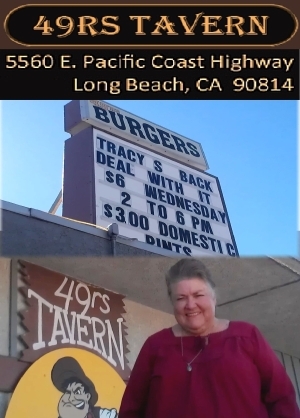- Commitment to Advancing Clean Technology: As Climate Mayors, declaring our Cities and Ports shall advance clean technologies and other efforts to move toward the goal of zero emissions to reduce emissions and combat climate change.
- CAAP 2017 Update: Ensuring the creation and approval of a 2017 CAAP Update by November 2017 that is bold in achieving a clear timeline and sets measurable milestones to help ensure progress toward near-term regional air quality attainment goals -- including through zero and near-zero technologies -- as well as our ultimate goals of zero emissions for cargo-handling equipment by 2030, and zero emissions for on-road drayage trucks serving the ports by 2035. The Updated CAAP should also include and highlight the following:
- Expand At-Berth Emissions Reduction: Both Ports will work together to encourage increased testing and development of all forms of at-berth emission control systems, including systems for non-regulated container fleets, as well as ships that move other types of cargo into and out of the ports.
- Drayage Truck Test Pilot Program(s): The Ports will individually and/or collectively, in the San Pedro Bay, develop pilot program(s) to test zero emissions drayage trucks at scale (e.g., 50 to 100 zero emissions on-road, short haul drayage trucks operating at one time) in order to stimulate the production of these vehicles, demonstrate feasibility, and provide meaningful data in real world Port operations. The pilot program(s) will be an initial step towards achieving zero emissions on-road drayage truck operations, and to utilize market maker strategies (e.g. RFI to OEMs, etc.) as well as grant funding (pending availability). Strategies to implement the pilot program could include accessing funds through local, state, or federal grant funding (subject to funding availability), utilizing responses to the Green Ports Collaborative Request for Information ("RFI"), and/or creating a specific pilot program RFI that sets forth performance goals and allows the private sector to respond with strategies for acquiring the vehicles and operating such a program.
- Expand technology advancement programs: In addition to the drayage truck test pilot programs described above, the Ports will continue to conduct technology advancement programs with industry partners and will share the results of this work with the goods movement industry. This work will include testing and demonstration of zero emission cargo handling equipment, as well as development harbor craft emission reduction technology projects. Additional efforts will include standardizing plug-in equipment for electric vehicles, development of demonstration testing protocols, and establishing feasibility and operational performance requirements for zero/near-zero equipment. o Timeline, Process and Communication: Within 15 days of our signing this declaration, the Ports will release a final timeline and process for the development and submission of a Proposed Final 2017 CAAP Update to the combined Boards of Harbor Commissioners (Boards) by November 2017, as well as a subsequent 2017 CAAP Update Reporting Plan that includes a commitment among the Mayors, the Boards and staff, and all Approved Final Text stakeholders to communicate regularly and in a timely manner as the updated CAAP programs are developed and implemented at the Ports;
- CAAP Implementation Stakeholder Advisory Group: Building upon the work of the City of Los Angeles Sustainable Freight Advisory Committee, Supply Chain Optimization efforts of the Ports, the State Sustainable Freight Action Plan process, and ongoing CAAP stakeholder outreach activities, create a San Pedro Bay CAAP Implementation Stakeholder Advisory Group of key public and private industry stakeholders, including Southern California Edison, Los Angeles Department of Water and Power, related Port and City staff, and key partners to advise the Ports regarding details of CAAP implementation and further ongoing operational efficiency programs to move toward zero emissions goods movement. As part of this work, the CAAP Implementation Stakeholder Advisory Group shall report to us via quarterly progress reports and detailed annual reports on CAAP implementation progress, as well as related issues such as the potential for energy efficiency improvements (e.g. LED lighting), onsite renewable energy generation, and energy storage.
- Green Ports Collaborative: Working initially with our fellow Climate Mayors and ports on the West Coast (and later expanding nationally), launching the Green Ports Collaborative to advance similar goals by working together to reduce emissions and to protect public health. As with the Climate Mayors Electric Vehicle Request for Information (EV RFI), the core to the initiative will be establishing an RFI to aggregate, demonstrate, and create markets that grow demand for zero emissions goods movement vehicles and equipment to encourage OEMs and manufacturers to invest, produce at scale to reduce costs per vehicle and provide the needed infrastructure. This collaborative will include shared goals, specific pilots between all or groups of ports and/or cities, peer-to-peer information sharing, regular communication, field and technology visits, and collaboration with key industry, government, and nonprofit partners.
- Securing equipment and infrastructure funding: Working together to secure public and private partners and necessary funding to implement both 2017 CAAP Update programs and supporting infrastructure from the State of California, the California Air Resources Board, the California Public Utilities Commission, California Energy Commission, the South Coast Air Quality Management District, and federal government agencies, along with the Ports and industry.
- CAAP 2017 Update: Ensuring the creation and approval of a 2017 CAAP Update by November 2017 that is bold in achieving a clear timeline and sets measurable milestones to help ensure progress toward near-term regional air quality attainment goals -- including through zero and near-zero technologies -- as well as our ultimate goals of zero emissions for cargo-handling equipment by 2030, and zero emissions for on-road drayage trucks serving the ports by 2035. The Updated CAAP should also include and highlight the following:
Sponsor | Sponsor |
The Clean Air Action Plan (CAAP) referenced in the document surfaced in 2006 after legislation advanced in Sacramento (authored by then-Assemblyman later state Senator Alan Lowenthal) that sought to require the Ports to demonstrate "no net increase" in pollution. Both Ports strongly opposed two bills that sought to require this: one was vetoed in 2004 by Governor Schwarzenegger, another was killed in 2006 by Assembly Democrat leadership (amnesia file details below).
As a result, the public is now left with a Clean Air Action Plan whose text is written by the Ports and whose goals are set and decided by the Ports.
In Feb. 2010, the Ports updated their CAAP and in November 2016 released a draft update they labeled a draft discussion document. (The Ports issued a joint press release summarizing the draft here.)
Written responses to the draft CAAP update were mixed. Multiple commenting parties commended the Ports for making progress, but some said it hasn't gone far enough fast enough.
Earthjustice, the West Long Beach Association, Center for Community Action & Environmental Justice, Comite Civico Del Valle, Inc., East Yard Communities for Environmental Justice, End Oil/Communities for Clean Ports, Long Beach Alliance for Children with Asthma, Natural Resources Defense Council, South Bay Los Angeles 350 Climate Action Group jointly submitted comments stating in part:
- Emissions Targets -- We are deeply disappointed that the revised CAAP does not include revised emission targets from the ones developed in 2006 and targets beyond 2023. The South Coast Air Quality Management District has identified the twin ports as the largest fixed source of pollution in the region. The Ports appear to conflate meeting emission targets established in 2006 with achieving safe, healthy air. Even with reductions since 2005, the Ports still impose high risks to neighboring communities and contribute greatly to our region's failure to meet state and federal air quality standards. The Ports should establish revised goals given that there is a consensus from our state and local air quality agencies that more reductions are needed...
- Zero Emission Trucks -- We are pleased to see a commitment for all zero emission drayage trucks by 2035. This is a significant and necessary goal that needs to be set. However, noticeably absent from the Discussion Draft is a real roadmap with interim goals and milestones. These interim steps must be included because the current approach provides little accountability and short-term actions. The Ports must lay out a cogent plan to actually achieve zero emission truck technologies, including targeting segments of the drayage market (i.e. those traveling shorter distances) that can achieve 100% zero emissions sooner than 2035.
- Railyards Must Reduce Emissions -- Pollution from railyards must be addressed in a real and meaningful way. To date, this has been the source category with the least success. For more than a decade, communities adjacent to railyards have asked for relief from the high levels of toxic pollution. The Ports must do more to ensure their business partners -- the Class 1 railroads -- do their part of clean up the toxic levels of emissions in our communities.
- Need for Robust Community Engagement -- We are surprised by the paltry community engagement to date. The initial Clean Air Action Plan included significant outreach and involvement with community and environmental groups. This stakeholder process provided necessary input on how to achieve success, measure success and ensure progress was actually made. We suggest that the Ports collaborate with our organizations to ensure it reaches and receives input from a broad set of community and environmental stakeholders.
Sponsor |
Sponsor: Computer Repair Long Beach |
The Coalition for Clean Air commented:
Our initial assessment has identified the several issues with the Discussion Draft. Our recommendations are:
- Public health - The highest priority should be the protection and improvement of public health. The ports should make this explicit.
- Criteria -- The ports need to specify the criteria that they will use to determine the feasibility of fulfilling CAAP commitments. Failing to identify these criteria undermines the credibility and meaningfulness of these commitments. Without explicit assessment criteria identified in advance, the ports leave stakeholders with the uncertainty of whether the emission reduction commitments will be met. This uncertainty makes business decisions more difficult, leaves clean technology developers and manufacturers without a market and unable to raise and sustain investment capital, and increases despair among community members who hope and count on the ports to reduce the environmental and quality of life impacts of port operations on them where they live, work, and play.
- On Dock Rail Mode Shift - To avoid simply transferring the environmental and public health burdens of port operations onto another community, the development of one or more inland ports must include a firm commitment to using 100% zero emission locomotive, off-road, and short-haul heavy duty truck technologies.
- Emissions Targets -- We are deeply disappointed that the revised CAAP does not include revised emission targets. The South Coast Air Quality Management District has identified the twin ports as the largest fixed source of pollution in the most polluted air basin in the country. The emission inventory projections submitted to the air district and incorporated in the 2016 Regional Transportation Plan include a projected 14% increase in the key smog precursor emissions, oxides of nitrogen (NOx), by 2023. This backsliding is unacceptable. The Ports appear to conflate meeting emission targets established in 2006 with achieving safe, healthy air. The ports continue to impose unacceptably high environmental health risks to neighboring communities and contribute greatly to our region's failure to meet state and federal air quality standards. The ports should commit to new air pollutant emission reduction targets...
CCA believes that everyone has the right to breath clean air. Established in 1971, CCA is California's only statewide organization exclusively advocating for improving air quality and preventing climate change. CCA helps policy makers, businesses, and individuals make good clean air choices that protect and improve public health in California. CCA's priorities include ensuring that climate investments and benefit disadvantaged communities and promoting zero and near-zero emission technologies
Sponsor | Sponsor |
To download all comments through May 9, 2017, click here.
For a summary of written comments received through February 2017, click here.
Regarding the record of the two Mayors on Port related global warming and pollution matters:
- Long Beach Mayor Garcia presided at the hearing and voiced no objections when the Long Beach City Council voted in August 2014 to overrule an appeal by environmental groups (NRDC and others) that let the Port of Long Beach use a 1992 Environmental Impact Report (instead of requiring an updated EIR with new information and standards) to allow new 15-20 year contracts (leases) with firms that store bulk petroleum coke and coal for export through the Port of Long Beach. (The material is shipped to destinations including the world's worst greenhouse gas emitter, the Peoples Republic of China.)
- Los Angeles Mayor Garcetti and to a lesser extent Mayor Garcia have received criticism for their stances toward a proposed railyard on the L.A.-WLB border, sought by BNSF and the Port of L.A. (the "Southern CA International Gateway"). A number of environmental and neighborhood groups said the railyard's impacts couldn't be mitigated and said the project shouldn't be built at that location and they hammered L.A. Mayor Garcetti for supporting the railyard. The City of Long Beach (under then-Mayor Bob Foster (with Garcia a policy-setting Councilmember) didn't publicly support the project...and stopped short of flatly opposing the project. However, the City of Long Beach joined in a court challenge to the proposed railyard's Environmental Impact Report, and in March 2016, a trial court struck down the EIR. In August 2016, BNSF and the Port of L.A. indicated they will appeal the trial court's ruling. The net result leaves open the possibility that under L.A. Mayor Garcetti and LB Mayor Garcia, the two cities might settle the litigation to let the industry-favored railyard go forward in exchange for Long Beach receiving some type of compensation or other "mitigation."
Sponsor |  |
In 2003, then-Assemblyman Alan Lowenthal (D, LB-SP-PV) introduced AB 2042, a measure that would require the City of Long Beach for the Port of Long Beach, and the City of Los Angeles for the Port of Los Angeles, to require that growth and operations at their ports be limited or controlled with measures -- that the ports were free to decide -- that would prevent air pollution at the ports from exceeding a specified baseline. The bill would require each city, on March 1, 2006, and every March 1 thereafter, to report to the district regarding the city's compliance with this requirement, including an accounting of the city's programs and efforts directed towards that compliance.
The measure was supported by the SCAQMD and the City of Long Beach on an 8-0 City Council vote (Vice Mayor Colonna absent for entire meeting) but was opposed (under Mayor O'Neill) by LB's Mayor-chosen, Council-approved Harbor Commission. AB 2042 passed the Assembly and passed the state Senate...but amid stiff opposition by the Port of LB, the CA Ass'n of Port Authorities and other industry interests, Governor Schwarzenegger vetoed the bill in 2004.
That outcome angered clean air advocates and in 2005, then-state Senator Alan Lowenthal (D, LB) re-introduced his "no net increase" legislation as SB 764. This time, the Port of LB remained publicly neutral while letting the CA Association of Port Authorities (in which the Port of LB was a major player) and other industry interests kill the bill.
SB 764 cleared the state Senate but was killed by Assembly Democrat leadership. In an August 2006 action that effectively avoided an embarrassing Assembly floor vote, then-Assembly Appropriations Committee chair Assemblywoman Judy Chu (D, Monterey Park) simply announced that she was holding the bill in her Committee, blocking its advance, effectively killing it for that legislative session. Assemblywoman Chu's action took place in the presence of then-Assemblywoman (former state Senator) Betty Karnette (D, LB), who was a member of the Assembly Appropriations Committee and said nothing.
Former Assemblywoman Chu and former Assemblyman/former state Senator Lowenthal are now both Democrat members of Congress. Assemblywoman/former state Senator Karnette has retired.
blog comments powered by Disqus
Recommend LBREPORT.com to your Facebook friends:
Follow LBReport.com with:
RSS |
Contact us: mail@LBReport.com





Hardwood Floor Specialists
Call (562) 422-2800 or (714) 836-7050
